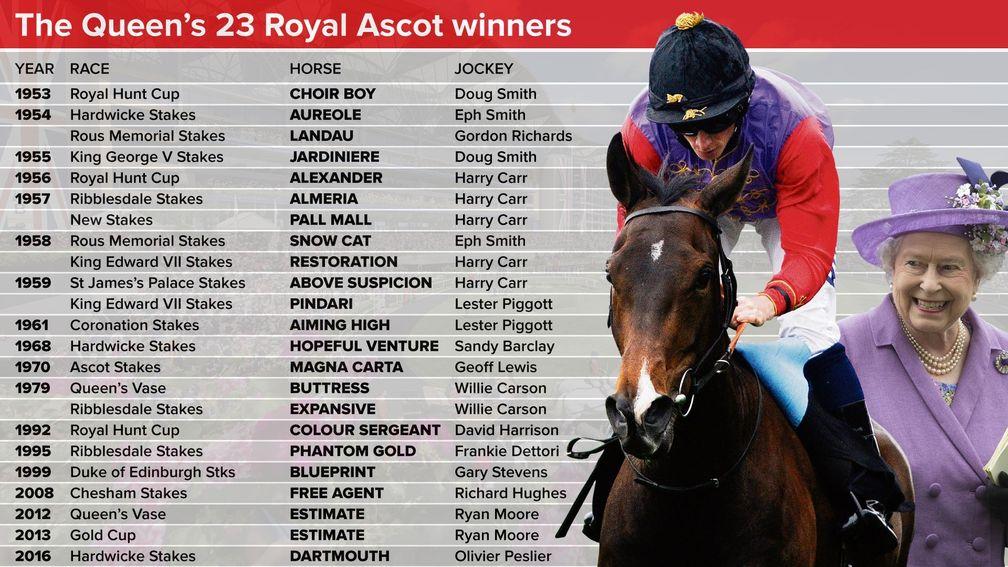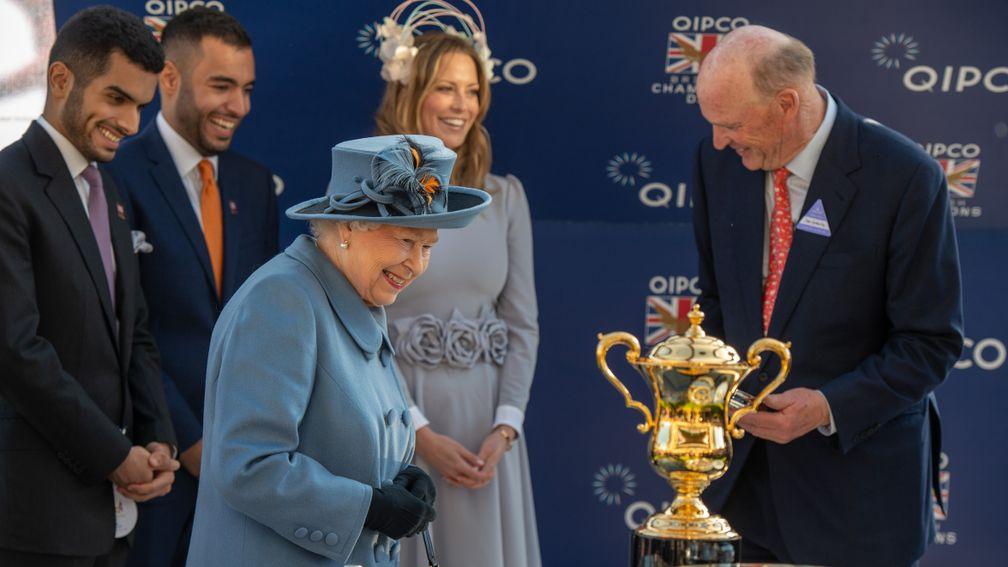The Queen is racing's most famous face but what is the best measure of success?
Lee Mottershead assesses the royal owner-breeder's achievements

There is nothing more popular than a winner at Royal Ascot for the lady hosting the party. That would be true again next week, when some of the Queen's most talented horses will represent her at racing's most famous meeting.
Yet although she is undoubtedly racing's most famous owner, has the Queen enjoyed success commensurate with her standing?

To answer that question fairly there is a need to understand why she races and breeds horses. There is a need to understand how she herself interprets success. When assessing the Queen's impact on the sport she adores, success assumes a broad scope.
A happy and glorious past
Before seeking to interpret the present, we should first remember the past. With the Queen and racing, there is much of it.
She inherited the royal Flat string following the death in 1952 of her father, King George VI. The very next year she finished second in the Derby with Aureole – subsequently winner of the 1954 King George VI and Queen Elizabeth Stakes – and then had her initial taste of Royal Ascot celebration with Choir Boy in the Royal Hunt Cup.

Carrozza became her first of five British Classic winners in the 1957 Oaks, one season before Pall Mall took the 2,000 Guineas.
The 1960s were a quieter time for the purple, gold, scarlet and black silks, but in the 1970s the Queen's fortunes were revived by two marvellous fillies. In 1974 Highclere captured the 1,000 Guineas before following up in the Prix de Diane, while Dunfermline was victorious in the Oaks and St Leger during the Silver Jubilee year of 1977.
Fast forward to the Queen's Diamond Jubilee year and there were also major racing celebrations, thanks to Estimate, who won the Queen's Vase before posting an unforgettable triumph the following year in the 2013 Gold Cup.
Explaining the Group 1 gap
When Estimate won the royal meeting's signature prize she ended an awfully long wait, becoming her owner's first British Group 1 winner since Dunfermline.
During the intervening years certain events played a part in shaping the Queen's fortunes.
None of her mares visited Irish stallions for an extended period due to the terrorist war waged on Britain and British interests. Although that inevitably hurt the royal racing families, the potential dangers that would have been faced by those individuals caring for the Queen's horses – and indeed the horses themselves – were deemed significant.

Also important was the 1982 sale of Highclere's high-class filly Height Of Fashion to Hamdan Al Maktoum. The transaction enabled the Queen to purchase West Ilsley Stables but it denied her the services of what would have been her greatest broodmare, as Height Of Fashion gave birth to Nashwan, Nayef and Unfuwain.
Yet at the time the Queen could not possibly have known Bustino's daughter would prove to be such a stud sensation, and nor would she have sent her to the American stallions with which Height Of Fashion bonded so exceptionally well.
Consider as well that prior to Taghrooda's victory in the 2014 Oaks Sheikh Hamdan had gone four years without collecting a European Group 1. The scale of his racing and bloodstock empire is hugely greater than that of the Queen, for whom it has never been about numbers.
Time to start number-crunching
When considering those numbers, it is important to stress the Queen finances her racing and breeding interests entirely out of her private purse, with no public money used.
During the 2018-19 jumps season she raced seven horses. However, jumping was always her mother's passion. The Queen's great love is Flat racing.

It is not stretching the truth to say her racing fortunes are stronger now than they have been for some time. She will head to Ascot with legitimate prospects of adding to her royal meeting haul of 23 victories, the most recent of which was achieved by multiple Group-race winner Dartmouth in the 2016 Hardwicke Stakes.
That year Dartmouth was responsible for three of 23 wins for the Queen. In both 2001 and 2002 she had managed only six. Last year there were 19 firsts and a notable Grade 2 triumph in America courtesy of the William Haggas-trained homebred Call To Mind. The Queen's total British prize-money earnings of £374,755 placed her 31st in the 2018 owners' championship table.
To gauge the current scale of the royal bloodstock squad, one can take as an example the 2016 foal crop that has yielded the Queen's current three-year-olds.
A total of 26 live foals were recorded. While the actual covering fees paid between stallion and mare owners are not formally published, it is evident the Queen's bloodstock investment has become much bigger now she is using the likes of Galileo, Dubawi, Frankel and Sea The Stars.
Reaping the rewards of friendship
The Queen's two highest-profile horses of recent years were unusual in that they were not strictly bred by their owner but rather came from associations that could significantly improve royal racing bloodlines over the coming years.
Estimate was bred in conjunction with the Aga Khan, who had suggested giving the Queen one of his mares as an 80th birthday present. It was decided a more interesting gift would be if the two breeders worked together to select a small handful of mares and jointly choose which stallions they visited, the outcome being that the Queen would take the first filly each mare produced. One such filly is Estimate.
That has enriched the Queen's thoroughbred families, as will her relationship with Sheikh Mohammed.
In the autumn of 2009 the Godolphin founder asked to buy the Queen's Highland Glen. Knowing the horse was complicated, and therefore a potentially risky purchase, the Queen, in effect, gave Sheikh Mohammed the horse.
As a way of expressing his gratitude, the sheikh began an annual policy of giving the Queen yearlings. In the first batch was Carlton House, who in 2011 finished third in the Derby. Also a present was Magnetic Charm, who could race for the Queen in the Coronation Stakes on Friday.
So is it a success story?
While Group 1 glory has been elusive for the Queen over the years, she has come close and there have been extenuating circumstances. Encouragingly, a famine can give way to a feast, as evidenced by Anthony Oppenheimer, who prior to the Golden Horn and Cracksman era had gone 16 years without seeing a Group 1 landed in his family's silks.
Perhaps the biggest explanatory factor relevant to the Queen is she does not breed horses with the sole aim of finding Group 1 winners. She does not breed for commercial reasons. She breeds purely for passion.
Racing adviser John Warren says: "I quickly learned the Queen sees her breeding operation very differently to how a lot of other people see theirs.
"The Queen aspires to breed high-quality horses. Her Majesty is pragmatic enough to understand the odds of that happening year in, year out, are long, but that in itself stimulates the challenge.
"Her Majesty is a consummate horsewoman who is closely involved with the journey of each of her horses. As such, the Queen is delighted with all of her successes. However, she is also very accepting of the circumstances when things don't go according to plan.
"For Her Majesty, winning any race, whether it be big or small, provides her with tremendous satisfaction."

That is how the Queen regards success. There is, though, another aspect through which it can be measured, linked to the fact that as British racing's head of state the Queen ensures not only increased levels of publicity and interest for racing but also increased investment.
Senior racing PR figure Johnno Spence says: "I'm sure people underestimate the power of the Queen's patronage of racing. I genuinely think it is one of the sport's greatest assets. You only have to remember all the international coverage of Estimate winning the Gold Cup.
"The Queen's involvement is also massively important to certain major sponsorships. You cannot put a figure on it but the fact that the principal of a company will be pretty much guaranteed to meet the Queen is huge. Anyone who tried to deny that would be talking nonsense."
If you enjoyed reading this, you might like others from this series:
True or false: the truth behind popular punting myths
The art, rules and rudeness of naming racehorses

Published on inRoyal Ascot
Last updated
- What were the most - and least - bet on races at Royal Ascot?
- Jamie Spencer to miss Newmarket's July meeting after receiving eight-day whip ban for Royal Ascot ride
- Oisin Murphy: 'I don’t sit back and think 'that was great' - I need to keep going'
- French Group 1 'the ideal next spot' for 80-1 stunner Rashabar after special Royal Ascot for Brian Meehan
- 'We took a lot more euros from the Irish this year' - mixed feedback on Royal Ascot from on-course bookmakers
- What were the most - and least - bet on races at Royal Ascot?
- Jamie Spencer to miss Newmarket's July meeting after receiving eight-day whip ban for Royal Ascot ride
- Oisin Murphy: 'I don’t sit back and think 'that was great' - I need to keep going'
- French Group 1 'the ideal next spot' for 80-1 stunner Rashabar after special Royal Ascot for Brian Meehan
- 'We took a lot more euros from the Irish this year' - mixed feedback on Royal Ascot from on-course bookmakers